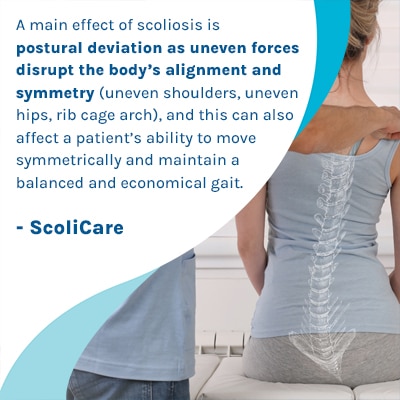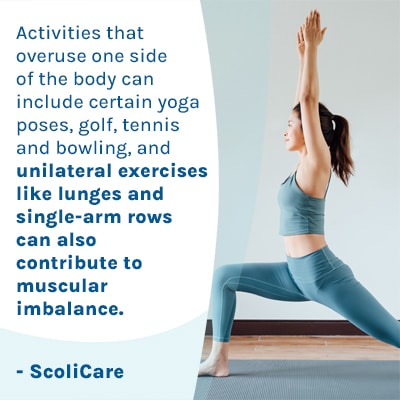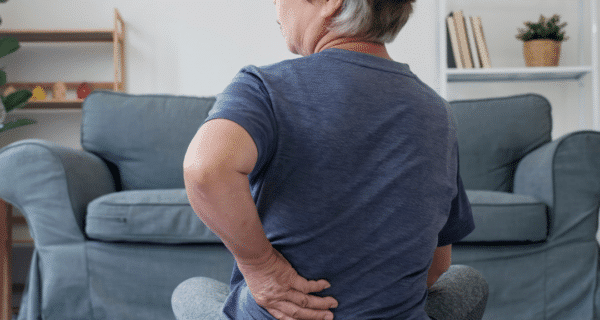Any type of sport or exercise needs to be deemed appropriate by a scoliosis patient’s treatment provider. People with scoliosis can benefit from exercise that helps maintain spinal flexibility and increases core strength so the spine has more support and stability, but some cases of scoliosis come with activity restrictions, and some exercises will need to be modified and/or avoided completely.
Scoliosis symptoms can include disruptions to movement, coordination, and balance. Scoliosis exercises to avoid include those that cause pain, worsen the curve, don’t use muscles evenly, and introduce compression. When corrective and scoliosis-specific, exercise can be a key facet of nonsurgical treatment.
Before getting to some specific exercises to avoid, let’s talk generally about how scoliosis affects the spine and body.
Scoliosis Effects
Scoliosis causes an unnatural lateral-bending and rotating spinal curve to develop, and a single unhealthy spinal curve can disrupt the strength and function of the entire spine, making it weaker and more vulnerable to injury (1, 2).
Each case of scoliosis is unique, which is why treatment plans need to be fully individualized (3).
Not only are there different scoliosis severity levels ranging from mild scoliosis to moderate and severe cases, there are also different condition types, curve types, and locations within the spine.
And in older adults, degenerative scoliosis that’s caused by natural age-related spinal degeneration can make the spine increasingly unbalanced, unstable, and put patients at risk of serious injury through a fall.
Postural Changes
 A main effect of scoliosis is postural deviation as uneven forces disrupt the body’s alignment and symmetry (uneven shoulders, uneven hips, rib cage arch), and this can also affect a patient’s ability to move symmetrically and maintain a balanced and economical gait.
A main effect of scoliosis is postural deviation as uneven forces disrupt the body’s alignment and symmetry (uneven shoulders, uneven hips, rib cage arch), and this can also affect a patient’s ability to move symmetrically and maintain a balanced and economical gait.
As a progressive condition, the nature of scoliosis is to become more severe over time, and progression is triggered by growth, so childhood scoliosis can involve rapid progression, especially in the most prevalent type of scoliosis: adolescent idiopathic scoliosis (1).
Adolescents experience rapid and unpredictable growth spurts during puberty, so a focus of treatment in childhood scoliosis is counteracting progression while the constant trigger of growth is occurring.
Scoliosis Pain
The majority of scoliosis pain is caused by compression, and as scoliosis doesn’t become a compressive condition until skeletal maturity has been reached, adult scoliosis is more associated with pain than childhood scoliosis.
So pain management is a focus of adult scoliosis treatment, while counteracting progression during growth is the focus of childhood scoliosis treatment
Scoliosis pain can involve muscle spasms and pain, back pain, and radiating pain felt in the hands and feet due to nerve compression, and as progression occurs, increasing spinal rigidity can cause increasing pain levels in adults.
Exercise can be helpful for scoliosis patients in a number of ways, one of which is pain management, but all exercise, sports, and activities need to be deemed safe by a patient’s treatment provider (4).
When appropriate, exercise can help patients maintain a healthy weight, spinal flexibility, and core strength.
Scoliosis and Activity Restrictions
Here at ScoliCare, treatment is patient-focused, and we work closely with our patients to provide guidance about their scoliosis, effects to expect, what to expect from treatment, and how to cultivate a healthy activity level that won’t strain the spine.
As mentioned, each case of scoliosis is unique, so while an activity or exercise may be deemed unsafe for one patient, it can be approved for another.
Activity restrictions are based on a number of factors including condition severity, experienced symptoms, and curvature location (2).
Generally speaking, the more severe scoliosis is, the more noticeable its effects may be, and the more disruptive it can be to life.
But while each case is different, there are some types of exercise that are generally deemed unsafe for people with scoliosis, and can include exercise that causes pain, exacerbates the curve, overuses one side of the body, and introduces compression (2, 4).
Exercises that Cause Pain
The old exercise adage of no pain, no gain does not apply to those living with progressive scoliosis.
A scoliotic spine is being exposed to uneven forces, and as the spine’s natural curves make it stronger and more flexible, the development of an unhealthy curve can make it weaker, more rigid, less functional, and more vulnerable to injury (2).
For children and adults with scoliosis, if an exercise is causing pain, it should be avoided because the spine and its surroundings are already strained and may experience increasing effects alongside progression.
Pain can indicate the spine is being strained or placed in an unnatural position, muscles are being strained, and to avoid injury and strain, painful exercises should be avoided.
Exercises that Worsen the Curve
As the nature of scoliosis progressive, we don’t want patients doing any exercise that exacerbates the unnatural spinal curve as this can strain the spine and interfere with treatment (2).
Exercises that involve hypertension (arching the back excessively) can put excessive pressure on the spine, and particularly with thoracic hyperextensions, this may worsen the curve.
Certain swim strokes, gymnastics, and diving are associated with hyperextension and generally may not be recommended for people with scoliosis.
Certain exercises can also worsen the spine’s rotation, so activities that involve repeatedly twisting the spine can increase the rotational component, thus worsening the curve, and this is common in gymnastics, certain yoga poses, dance, and golf.
Exercises that Overuse One Side of the Body
As one of the main effects of scoliosis is postural deviation that disrupts the body’s overall symmetry, exercises that don’t use the body’s muscles symmetrically should also be avoided as this can exacerbate muscular imbalance is a known effect of scoliosis (2).
Scoliosis doesn’t just affect the spine, but also its surroundings, and this includes the spine’s surrounding muscles that can become strained, sore, and unbalanced.
As the unnatural bend and twist in the spine pulls its surrounding muscles in opposing directions, muscles on one side of the spine can become sore from straining to counteract the spine’s unnatural pull, while muscles on the opposite side can become weak from lack of use.
When the muscles are out of balance, this can cause further postural deviation, pain, and increase uneven wear and tear on the spine.
Exercises that Introduce Compression
As scoliosis already introduces a number of uneven forces to the spine, its surroundings, and the entire body, activities and exercise that involve repeated shock from impact should be avoided.
Especially in adults for whom scoliosis is compressive, any activity that increases compression can worsen the curve, and this includes long-distance running, horseback riding, football, and long jump.
Lifting weights straight above the head can also strain the spine and introduce compression and uneven forces.
Ultimately, any activity, sport, or exercise that’s bad for the spine is bad for scoliosis, and the aforementioned activities can worsen the curve in different ways, either through postural changes, straining the spine, placing the spine in unnatural positions, exacerbating muscular imbalance, and uneven forces causing degeneration.
Conclusion
So will everyone with scoliosis have the same types of activity restrictions/approvals? No, each case is unique, but in general, exercise that causes pain, strains the spine, introduces compression, and/or doesn’t engage muscles symmetrically should be approached with caution or avoided completely.
Finding a healthy and balanced actively level is key to establishing a healthy spine- and scoliosis-friendly lifestyle; this can help patients maintain a healthy weight so the spine isn’t strained, spinal flexibility so the spine is more responsive to treatment, reduce pain, and can help keep the spine’s surrounding muscles strong and supportive.
In fact, scoliosis-specific exercise is a key facet of nonsurgical treatment offered at ScoliCare Clinics around the world.
When combined with a powerful corrective ScoliBrace®, a scoliosis-specific exercises program like ScoliBalance® (4) can work with the brace to slow/stop progression, reduce the curve, restore muscle strength and balance, reduce pain, maintain spinal flexibility and strength, and improve posture and the spine’s alignment.
ScoliBalance® is completely customized to address the specifics of a patient’s postural challenges, condition type, severity, and experienced symptoms. Largely through the use of Mirror Image® exercise, patients are taught the importance of postural awareness.
Knowing how to hold the spine and body during movement and daily activities can help counteract the scoliosis and sustain long-term treatment results.
When the spine’s balance and alignment are restored, the body’s balance and stability are improved, and this means better posture, movement, body appearance, and function.
References:
- Weinstein SL. The Natural History of Adolescent Idiopathic Scoliosis. J Pediatr Orthop. 2019 Jul;39(Issue 6, Supplement 1 Suppl 1):S44-S46. doi: 10.1097/BPO.0000000000001350. PMID: 31169647.
- Wong AYL, Chan C, Hiller C, et al. Is Scoliosis Associated with Dance Injury in Young Recreational Dancers? A Large-Scale Cross-Sectional Epidemiological Study. Journal of Dance Medicine & Science. 2022;26(1):42-50. doi:10.12678/1089-313X.031522f
- Negrini S, Donzelli S, Aulisa AG, Czaprowski D, Schreiber S, de Mauroy JC, Diers H, Grivas TB, Knott P, Kotwicki T, Lebel A, Marti C, Maruyama T, O’Brien J, Price N, Parent E, Rigo M, Romano M, Stikeleather L, Wynne J, Zaina F. 2016 SOSORT guidelines: orthopaedic and rehabilitation treatment of idiopathic scoliosis during growth. Scoliosis Spinal Disord. 2018 Jan 10;13:3. doi: 10.1186/s13013-017-0145-8. PMID: 29435499; PMCID: PMC5795289.
- Marchese R, Du Plessis J, Pooke T, McAviney J. The Improvement of Trunk Muscle Endurance in Adolescents with Idiopathic Scoliosis Treated with ScoliBrace® and the ScoliBalance® Exercise Approach. J Clin Med. 2024 Jan 23;13(3):653. doi: 10.3390/jcm13030653. PMID: 38337346; PMCID: PMC10856658.


